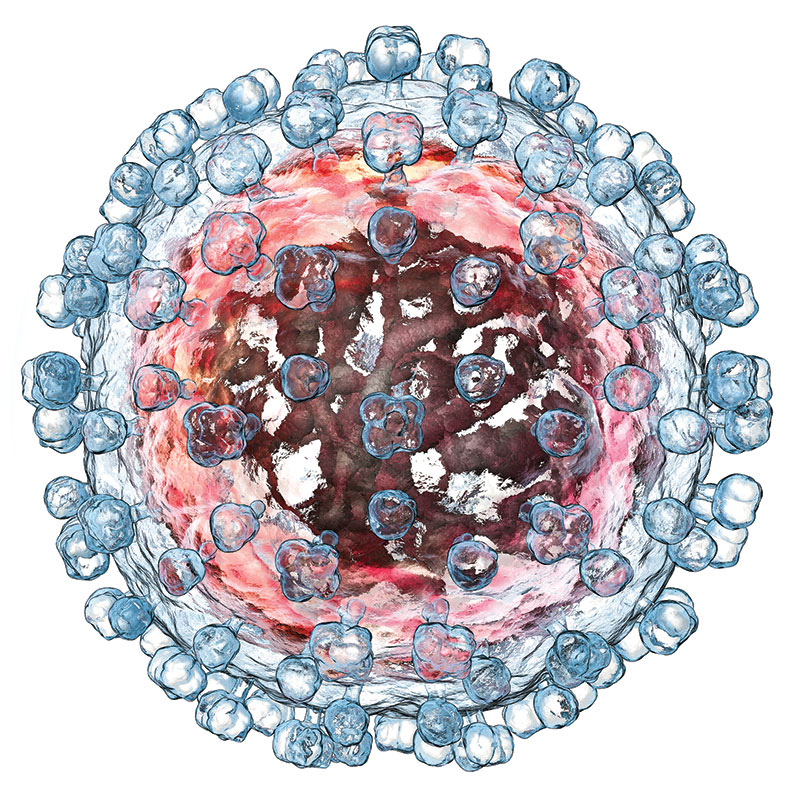
ViiV Healthcare announced that it has submitted a rolling new drug application (NDA) to the U.S. Food and Drug Administration (FDA) in May for cabotegravir as pre-exposure prophylaxis, or PrEP.
In two clinical trials, HPTN 083 and HPTN 084, one injection of long-acting cabotegravir showed superiority over daily use of Truvada, a PrEP medication already on the market. “HPTN” stands for HIV Prevention Trials Network.
Although tolerable and more than 95% effective in preventing HIV when used as prescribed, taking a daily pill of Truvada for PrEP can be burdensome for some people. New options are highly desirable—different strokes for different folks.
ViiV Healthcare reported that it plans to submit parts of its regulatory requirements as they are ready, starting in December. Hence a “rolling” application instead of submitting its evidence for a new drug approval all at once, as is usually done.
The FDA approved the NDA. Approval of the new PrEP medication could come as early as the first half of next year.
Cabotegravir for HIV therapy is used once monthly with another long-acting injectable, rilpivirine. The combination of the two gluteal (butt) shots are provided under the brand name Cabenuva.
Trogarzo: Update on infants
Based on animal data, the FDA updated the drug label for Trogarzo (ibalizumab-uiyk) in April to include the potential for immunosuppression in infants exposed to the medication inside the womb. The FDA said that while the 20 monkey moms given Trograzo in a study received a higher level than is used in people, the potential for immunosuppression in human infants “is possible.” In the infant monkeys exposed to Trogarzo in utero, there was observed a reversible effect on the immune system—a lower level of B cells and CD4 T cells within four weeks of birth. Most of the immuno-suppression observed disappeared one to three months after birth, as the drug left the body and concentrations were almost undetectable in the baby monkeys.
One of the exposed infants died 24 days after birth, however, from a systemic viral infection. The FDA reported it’s possible that the death was due to the drug exposure.
Trogarzo is a long-acting HIV medication important for its use in people who are highly treatment-experienced for whom many of the other medications won’t work.
The FDA also reported no “malformations or premature births” and stated that, “In addition, no maternal toxicities, including no changes in maternal lymphocyte subsets or effects on embryo-fetal survival, were observed.”
See Section 8.1 (Pregnancy) in the prescribing information at trogarzo.com.
Hep C meds for children
Two important medications for hepatitis C virus (HCV) can now be taken by even younger children than before. In June, the FDA approved new pellet formulations of Epclusa and Mavyret, allowing the age for treatment to drop. Epclusa can now be taken by children age 3 and older (as opposed to age 6 and older previously). Mavyret can now be taken by children age 3 and older (as opposed to age 12 and older previously).
“In the United States, as of 2018 there were approximately 35,300 to 60,500 children living with HCV and incidence has been on the rise,” reported Gilead Sciences, the maker of Epclusa. “Mother-to-child transmission, the most common cause of HCV infection in children, increased 161% from 2009 to 2017, with intravenous drug use representing the primary driver of HCV infection among women of childbearing age.”
See the Epclusa and Mavyret drug pages in this issue.
Treatment activists release diversity report on clinical trials
The AIDS Treatment Activists Coalition (ATAC) produced an extensive report analyzing data on diversity in HIV clinical trials conducted by pharmaceutical companies.
Led by Liz Barr, PhD, MS, the study reviewed participant demographics in HIV studies conducted 2010–2020 by four companies active in HIV research and development—Gilead, Janssen, Merck, and ViiV. ATAC gathered publicly available information from clinicaltrials.gov for HIV drug studies completed by the four companies, and analyzed study information to characterize trends in participant diversity.
Among HIV trial participants, the report found that male participants were over-recruited by 34%; race-specific data went unreported in 65% of studies, and, when reported, was incomplete. Geographic diversity was also lacking; a majority of study sites were in the U.S., although 75% of people living with HIV are in Africa and Southeast Asia.
Missing Data, Missing Diversity: Participant Demographics in Industry Studies 2010-20 can be read at AIDStreatmentactivists.org /diversity-report.
A five-minute video presentation of the report is at croiwebcasts.org/console/player/47450?mediaType=slideVideo, as part of a “Science Spotlight” for the Virtual Conference on Retroviruses and Opportunistic Infections (vCROI 2021).
La Bodega launches podcast
In last year’s hepatitis drug guide, writer Michelle Simek told the story of a special hepatitis C clinic in Buffalo, New York and its founding doctor, Anthony “Tony” Martinez, AAHIVS (“Not your basic bodega,” July+August 2020). This year, just in time for this hepatitis drug guide, Dr. Martinez has launched a podcast telling one patient’s story of substance use, hepatitis C diagnosis and treatment, and now leading the life she longed for. Dr. Martinez announced that the four-part series is a dream years in the making. He hopes it inspires others, including providers, with its story of triumph. The podcast is produced in collaboration with Practice Point CME. Available through Apple Podcasts, Google Podcasts, iHeartRadio, and Spotify; the podcast can be found at bit.ly/patient-perspectives-on-hcv-podcast.
Tony Martinez, AAHIVS
Happy anniversary, U=U
It was five years ago, in July 2016, when the U = U campaign kicked off and changed the world, letting everyone know that HIV cannot be transmitted by people with undetectable viral load who are on antiviral therapy. Undetectable equals Untransmittable (“U = U” for short) is the creation of the Prevention Access Campaign (preventionaccess.org), founded by Bruce Richman after he learned the astounding news that he could not pass on his HIV.
It was in 2006 when the Swiss Statement declared that people living with HIV who have undetectable viral load on antiviral therapy and no other STIs cannot transmit the virus through sexual contact. In the years before and since then, many struggles were made over the protective effect of HIV treatment for uninfected partners. But the knowledge today is solid. U.S. HIV treatment guidelines discuss Treatment as Prevention (TasP); go to hivinfo.nih.gov.
CDC issues new HIV numbers
Three new HIV surveillance reports were released May 27 by the U.S. Centers for Disease Control and Prevention (CDC). The cover letter tying in the statistics is a work of art. It’s from Demetre Daskalakis, MD, MPH, the CDC’s recently appointed Director of the Division of HIV/AIDS Prevention, for the agency’s National Center for HIV/AIDS, Viral Hepatitis, STD, and TB Prevention.
The good news? “Data suggest the progress seen in recent years is likely linked to increased uptake of key prevention and treatment strategies in recent years, such as pre-exposure prophylaxis (PrEP) and ongoing treatment and care, which are necessary to maintain viral suppression. These trends are encouraging although substantial gaps remain.”
Some key points made:
- “From 2015 to 2019, the number of HIV infections among MSM [men who have sex with men] decreased 9% overall and infections among young MSM aged 13-24 years declined 33% overall, with declines in young MSM of all races, although young Black/African American and Hispanic/Latino MSM continue to be severely and disproportionately affected.
- “In terms of overall race/ethnicity, while HIV infections were somewhat lower in 2019 among African American, Hispanic/Latino, and White persons than in 2015, none of these declines were statistically significant—but, together, they contributed to an overall national-level decline.
- “The South also continues to be disproportionately affected, accounting for more than half of new HIV infections in 2019.
- “The number of HIV infections in 2019, compared with 2015, remained stable among persons who inject drugs (PWID), due likely in part to the ongoing opioid crisis.
- “Finally, the estimated percentage of diagnosed infections among persons living with HIV at year-end 2019, compared with 2015, increased 2%. At year-end 2019, an estimated 1.2 million persons aged 13 years and older were living with HIV infection, including about 13% of persons whose infection had not been diagnosed”
“Overall, these reports suggest improvements in linkage to care, viral suppression, and increased PrEP use are likely contributing to recent progress,” Dr. D’s letter continues. “However, the reports also signal an urgent need to expand and improve HIV prevention, care, and treatment for groups who could most benefit.”
See Dr. Daskalakis’s full letter, with links to the three reports (including PrEP use), at bit.ly/CDC-new-report-2021-05-27.
Harold Phillips is the new director of the Office of National AIDS Policy
New AIDS czar named
The Biden administration’s new AIDS czar is an out gay Black man who’s been living with HIV since 2005. Harold Phillips has been named director of the White House Office of National AIDS Policy (ONAP).
Phillips has more than 20 years’ experience in the field. He most recently served as senior HIV advisor and chief operating officer of the Ending the HIV Epidemic (EHE) initiative in the Office of Infectious Disease and HIV/AIDS Policy (OIDP) at the U.S. Department of Health and Human Services. Before that, he was director of the Office of HIV/AIDS Training and Capacity Development at the Health Resources and Service Administration’s HIV/AIDS Bureau, where he was deputy director of the Ryan White HIV/AIDS Program Part B and AIDS Drug Assistance Programs. He has also previously worked at NMAC (formerly the National Minority AIDS Council).
In an open letter to Phillips, NMAC CEO Paul Kawata said, “With your new appointment, community needs you to fight. While we are very happy that you got this job, it only works if you fight for us. As a member of the White House’s Domestic Policy Council, we need you to bring the fight to end HIV to them. Too many people think the epidemic is over. Your voice represents more than you, it is the voice of the multitude of communities fighting HIV.”
Kawata added that among the communities needing to be addressed are long-term survivors and people aging with HIV. “While PLWH are living longer, they also face multiple challenges from aging and HIV,” Kawata said. “The Biden-Harris administration needs to create and implement a comprehensive ‘standard of HIV care’ for this growing community.”
As ONAP director, Phillips said he plans to incorporate the Biden-Harris administration’s priorities into the current strategy, and include additional input from other federal agencies to help address social determinants of health and improve health equity.
Read the announcement of Phillips’ appointment here: bit.ly/new-White-House-AIDS-czar-appointed. —Rick Guasco
HIV treatment guidelines updated
Several updates were made June 3 to the U.S. HIV treatment guidelines from the Department of Health and Human Resources (DHHS). The guidelines are regularly updated by a panel of experts.
- “The Panel now recommends that a dolutegravir (DTG) [Tivicay, found in Dovato, Juluca, and Triumeq]-based regimen can be prescribed for most people with HIV who are of childbearing potential.
- “Raltegravir [Isentress]-based regimens as initial antiretroviral therapy (ART) have been moved from the category of ‘Recommended Initial Regimens for Most People with HIV’ to ‘Recommended Initial Regimen in Certain Clinical Situations.’
- “For patients with virologic failure, the Panel’s recommendation of ‘A new regimen should include at least two, and preferably three, fully active agents’ has been changed to ‘A new regimen can include two fully active drugs if at least one with a high resistance barrier is included (e.g., DTG or boosted darunavir [Prezista; Prezcobix]).’
- “[The section on ‘Poor CD4 Recovery and Persistent Inflammation’] has been revised to include updates on studies describing mechanisms for declining CD4 counts despite suppressive ART [undetectable viral load] and a review of the status of experimental interventional strategies to reduce persistent inflammation. It also includes an explanation for why monitoring levels of inflammation is not currently recommended in clinical practice.
- “[The section on ‘Adolescents and Young Adults with HIV’] has been revised extensively to include current epidemiologic data on HIV in adolescents and young adults (AYA) in the United States, unique challenges faced by this population compared to their adult counterparts, [and] the importance of assisting AYA in navigating optimal transition from pediatric to adult clinical care setting.
- “[The section on ‘Women with HIV’] has been updated to include a review of the literature on weight gain in women after initiation or switch of ART. Updated data describing the prevalence of neural tube defects in infants born to women who were receiving either DTG or efavirenz [Sustiva, found in Atripla] during conception have been added. Information regarding hormonal therapy and antiretroviral (ARV) drug interactions has been updated. A new subsection offering considerations regarding menopause in women with HIV and its potential impact on ART is included.
- “A subsection has been added to [the section on ‘Substance Use Disorder and HIV’] discussing factors to consider when contemplating the use of long-acting injectable CAB plus RPV [Cabenuva] in people with substance use disorder and HIV.”
Other updates include tuberculosis (TB) treatment, cost considerations for HIV therapy, and drug interactions (including information about Cabenuva and Rukobia). See “What’s New in the Guidelines?” at clinicalinfo.hiv.gov/en/guidelines/adult-and-adolescent-arv/whats-new-guidelines. Go to hivinfo.nih.gov.
U.S. plan to end viral hepatitis
Yes, the U.S. has a plan. In fact, this year saw the fourth version of it in a decade.
“Viral hepatitis is a serious, preventable public health threat that puts people who are infected at increased risk for liver disease, cancer, and death,” says the Viral Hepatitis National Strategic Plan for the United States: A Roadmap to Elimination (2021–2025), or “Hepatitis Plan” for short.
While previous versions looked at all hepatitis viruses (A–E), the latest focuses on A, B, and C. And as the document points out, A and B can be prevented by vaccines, and C can be cured 95% of the time in eight to 12 weeks with a tolerable course of treatment.
So, what’s the problem?
There’s still a need for more people to get tested and treated. Among other things, the ongoing opioid epidemic has led to an increased rate of hepatitis C virus (HCV) infections among young adults. And it’s known that as with HIV treatment, hepatitis therapy has the added benefit of preventing transmission to sex partners.
But people often don’t go in for testing or treatment due to stigma, discrimination, payor resistance, and other problems.
Shades of HIV, the Hepatitis Plan points to a syndemic behind the problem of viral hepatitis. According to the document, “A syndemic occurs when health-related problems—such as viral hepatitis, HIV, STIs, substance use disorder (SUD), and social determinants of health—cluster by person, place, or time.”
“Communities disproportionately impacted by viral hepatitis often grapple with a range of challenges across the social determinants of health. The interplay of factors such as poverty, inadequate housing and transportation, food insecurity, medical mistrust, access to care, access to mental health care, language and cultural barriers, education, stigma, and discrimination must be addressed to reduce health disparities,” according to the report. “People with viral hepatitis face stigma and discrimination because of a number of factors (for example, SUD, risk behaviors, sexual orientation, gender identity, race and ethnicity, co-infection with HIV) in addition to the stigma associated with viral hepatitis. Intersectional stigma may impact prevention and care-seeking behavior.”
Which is why, the document notes, that, “An integrated approach to hepatitis and related public health challenges will reduce fragmented care and ultimately reduce viral hepatitis infection rates. This Plan lays a roadmap to integrate prevention, screening, and linkage to care for all components of the syndemic, so that we can meet people where they are with no wrong point of entry to health care and related systems. This approach is especially important for people in at-risk settings and circumstances, such as people experiencing homelessness, people with an SUD, and people in correctional systems, for whom system-wide solutions pose additional and unique challenges.”
For gay and bisexual men, for example, 10% of new hepatitis A and 20% of new hepatitis B infections are in this group, despite the availability of vaccination. Moreover, “Gay, bisexual, and other men who have sex with men, in particular those with HIV, also have a higher chance of getting hepatitis C.” Risk factors include condomless receptive anal sex, exposure to blood during sexual activities (again, without taking precautions), the presence of another STI, and sometimes recreational drug use.
Positively Aware Hepatitis Editor Andrew Reynolds points out that the plan “has been around since the Obama years. And there’s no funding given to put the plan into action.”
Despite the advocacy concerns, the comprehensive plan has seen some positive results.
For the 2020 goals, for example, the plan is “on track” for reductions in deaths related to hepatitis C both among African Americans specifically as well as in the general population. “Trending in the right direction” is the provision of hepatitis B vaccination for newborns (pregnant women with hepatitis B risks should be vaccinated). But other goals to be achieved by last year, such as reducing new hepatitis C infections among people aged 20 to 39, are “not on track.” (Statistics take a while to be collected and analyzed, which is why results for 2020 are not yet in.)
“Treatment for SUD and harm reduction approaches, such as SSPs [syringe services programs], have been shown to prevent an estimated 75% of hepatitis C infections, but these interventions must be maintained over time,” the plan notes.
There are five overarching goals:
- Prevent new viral hepatitis infections
- Improve viral hepatitis-related health outcomes of people with viral hepatitis
- Reduce viral hepatitis-related disparities and health inequities
- Improve viral hepatitis surveillance and data usage
- Achieve integrated, coordinated efforts that address the viral hepatitis epidemics among all partners and stakeholders [referring to, for example, health departments and people with viral hepatitis]
With a blueprint out there for all to see—providers and advocates alike—the Hepatitis Plan may be on track to see its vision statement fulfilled:
“The United States will be a place where new viral hepatitis infections are prevented, every person knows their status, and every person with viral hepatitis has high-quality health care and treatment and lives free from stigma and discrimination. This vision includes all people, regardless of age, sex, gender identity, sexual orientation, race, ethnicity, religion, disability, geographic location, or socioeconomic circumstance.”
Go to bit.ly/hhs-hepatitis-strategic-plan.
There is also an Opioid Plan, bit.ly/hhs-opioid-plan.
Correction
In “The Forgotten Generation” (May+June 2021), Emily Carson’s correct age is 31, not 36. Positively Aware apologizes for the error.





